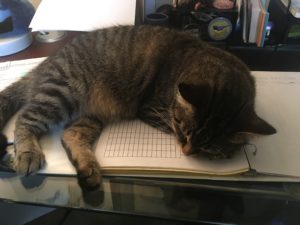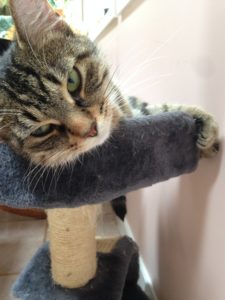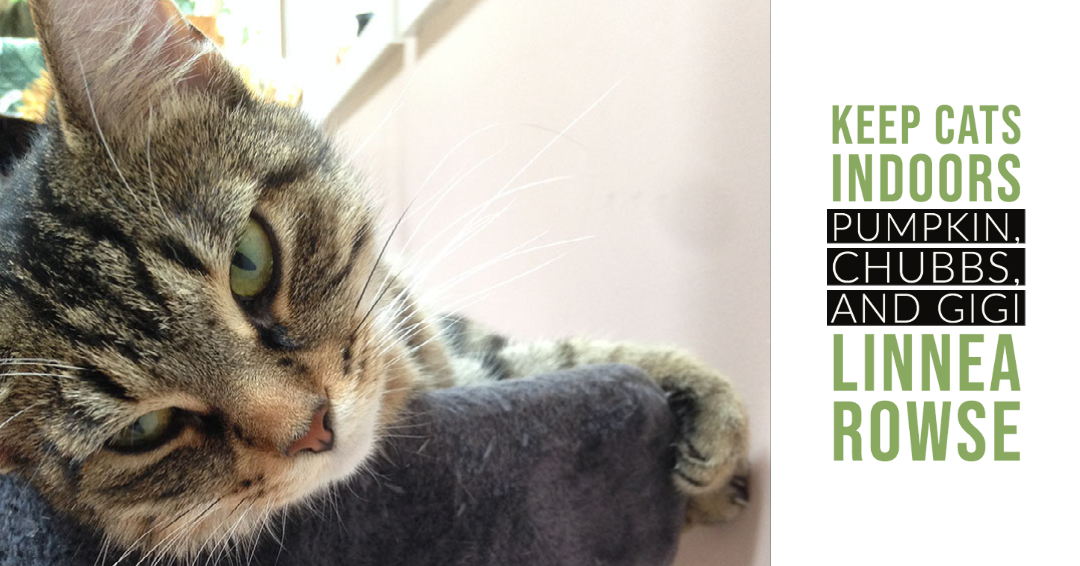This post is part of a series, sharing stories from Michigan Audubon staff, volunteers, supporters, and more on what “Keep Cats Indoors” means to them. You can read the Michigan Audubon position statement on this important issue impacting bird conservation here. This story features Michigan Audubon Conservation Program Coordinator Linnea Rowse.

Gigi “helping” Linnea as she works from home.
I’d like to share the stories of a few of the cats I’ve had in my life. We all start somewhere in our learning process, and for me, that started (unknowingly) with an early loss of a pet to outdoor hazards.
As a young child, I experienced the terrible sadness and loss of finding a pet in her last living moments. Pumpkin, a tortoiseshell cat who was in my family’s life before I was born, was an indoor-outdoor cat. My parents, like so many at the time, adopted Pumpkin as a stray, and allowed her to continue to roam outdoors when she pleased. Despite being a wildlife biologist (father) and botanist/outdoor educator (mother), they didn’t have the current broad base of knowledge now available about the impacts of cats on our bird, mammal, and other wildlife populations. Pumpkin was a sweet lap cat when indoors and took to sharing my parents’ laps with my sister and me when we were young.
Pumpkin lost her life to antifreeze, coming across the sweet-smelling substance in the alley behind our house. Despite having a loving home and ready access to veterinary care, Pumpkin died because of one of the many health hazards to cats that exist when they are allowed to live outdoors.
Fast forward about twenty years, and I am adopting my first cat, one whom I can call my own pet (i.e. not a family pet — we had two cats after Pumpkin, who lived long, healthy, and happy lives — entirely indoors). I adopted Chubbs, a big black panther of a housecat when I was in graduate school — a pet to keep me company, and also a marker of my time as a traveling seasonal field technician being paused for the indeterminate future. Chubbs had many owners during his life, including those prior to me who allowed him to be an indoor-outdoor cat. I received Chubbs, a cat who loved to be outdoors, and through behavior changes of my own and his, we adapted to indoor-cat life together. On my end, I had to be careful when opening the front door, and on his, well, he adapted to wearing a kitty harness and leash. Chubbs never really got the hang of going for a walk, but I would sit in the front yard with him while he ate grass and lounged in the sun. Chubbs was a wonderfully happy and loving cat, giving kitty hugs when picked up, and ferociously chasing toys indoors. He didn’t *need* to be outdoors, despite living more than half his life in that indoor-outdoor type of situation.

Gigi enjoys lounging on her cat tree.
Now, I have a different kitty, another nearly ten years later. Gigi is a sweet, affectionate 1-year-old kitty, who came into my and my spouse’s life after the passing of our husky. She is completely an indoor cat, and will always remain so. Gigi finds lots of entertainment indoors, playing with us, silly games like running around and up her cat tower, or chasing a hand under a blanket. She loves to sit on her indoor windowsill perch, watching the birds who frequent our feeders and cackles at them enthusiastically. Gigi does not try to dart out the front door, and though we’ll consider a harness and leash in the future, she does not need to be outdoors for her happiness. We prefer to keep her healthy and happy, and risk-free from diseases, predators, and car accidents.
Having trained as a wildlife and conservation biologist, and having worked in the bird conservation field now for 12+ years, I find it surprising that the detrimental impacts of cats on bird populations (not to mention their huge impact on small mammals, reptiles, and amphibians as well) was not something I was fully aware of until about the past five or six years. It’s surprising to me that this information and knowledge (based on scientific research studies) was not more widespread until recently. I am grateful, however, for organizations with a national and global reach that are sharing the information and asking folks to be responsible pet owners — both for the health of their cats and for the health of our environment — the birds and other wildlife with whom we share space.
I encourage you, as a reader, to learn more about cats and their impacts. Use your sound logic and decision making, take it all in, and do something positive for your pet cat, your friends’ or family’s cat, and in doing so, do something positive for the birds.
by Linnea Rowse, Michigan Audubon conservation program coordinator
 Linnea is an avid birder, and though she doesn’t like to pick favorites, her unofficial favorite group of birds is warblers. Linnea grew up in Minnesota and feels lucky to have parents who encouraged her to get outdoors and got her involved with birding (i.e., participating in Birdathons!) at an early age. Linnea has been working in the avian conservation field for 11 years now, with work experience ranging from field research on breeding ecology of Black-throated Blue Warbler to Western Bluebird social behavior studies, to migration banding in New England, the Gulf Coast, and in the Rocky Mountains, to wintering ecology studies of American Redstarts in Jamaica. She worked for three years for Audubon New York, restoring young forest habitat for Golden-winged Warbler on private lands in northern New York, and was employed by Pheasants Forever to implement Farm Bill conservation programs in Ohio. Linnea received her B.S. in Wildlife and Conservation Biology from the University of Rhode Island, and her M.S. in Fisheries and Wildlife Science from The Ohio State University. Michigan Audubon’s core mission aligns well with Linnea’s own values — to connect birds and people, and to do so by employing sound conservation science, research, outreach, and education, and she looks forward to continuing to meet and work with others in the conservation community in Michigan.
Linnea is an avid birder, and though she doesn’t like to pick favorites, her unofficial favorite group of birds is warblers. Linnea grew up in Minnesota and feels lucky to have parents who encouraged her to get outdoors and got her involved with birding (i.e., participating in Birdathons!) at an early age. Linnea has been working in the avian conservation field for 11 years now, with work experience ranging from field research on breeding ecology of Black-throated Blue Warbler to Western Bluebird social behavior studies, to migration banding in New England, the Gulf Coast, and in the Rocky Mountains, to wintering ecology studies of American Redstarts in Jamaica. She worked for three years for Audubon New York, restoring young forest habitat for Golden-winged Warbler on private lands in northern New York, and was employed by Pheasants Forever to implement Farm Bill conservation programs in Ohio. Linnea received her B.S. in Wildlife and Conservation Biology from the University of Rhode Island, and her M.S. in Fisheries and Wildlife Science from The Ohio State University. Michigan Audubon’s core mission aligns well with Linnea’s own values — to connect birds and people, and to do so by employing sound conservation science, research, outreach, and education, and she looks forward to continuing to meet and work with others in the conservation community in Michigan.
Further Reading and Additional Resources
American Bird Conservancy’s Solutions for Pet Cats
Learn about catios and outdoor enclosures, harnesses, indoor enrichment, anti-predation devices, and more.
Researchers Identify Five Types of Cat Owners
Are you a conscientious caretaker, concerned protector, tolerant guardian, laissez-faire landlord, or a freedom defender?
Take the Michigan Audubon pledge to Keep Cats Indoors.
Share Your Story
If you would like us to share your story on what “Keep Cats Indoors” means to you, please reach out to Communications & Marketing Coordinator Molly Keenan at [email protected] for more details.

